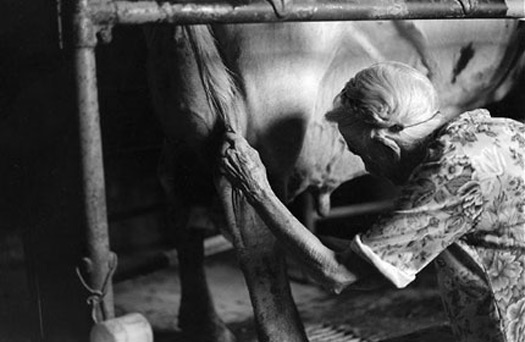
Dona Ann McAdams, From the portfolio “The Last Country”, Georgie Hurd, West Virginia, 1998
Only a few generations ago, cows, horses, oxen, pigs, sheep and goats formed part of Americans’ everyday cosmology. Even in our cities we lived among ungulates. They were a constant reminder that our human lives depended upon the lives of other animals. Over the last century, animals who fed us disappeared from public life. Hidden behind factory walls or locked in feedlots, their lives became unfathomable to most Americans, who encountered their ungulates only when served — unrecognizably — on a plate.
What is the cost of living separate lives from animals who feed us? Aside from the concerns about health — our own, the animals’, the planet’s — the larger cost may in fact be psychic. — from Brad Kessler, new afterword to Goat Song: A Seasonal Life, A Short History of Herding, and the Art of Making Cheese (paperback to be published by Scribner, June 2010)
Photographer Dona Ann McAdams works with underserved and overlooked communities, including Appalachian farmers, performance artists, asylum seekers and mentally ill residents of New York City homeless shelters. Recently, she began photographing working animals (racehorses, dairy cows, goats) and their human caretakers. This image is featured in her exhibition "Some Women" at the Opalka Gallery, in Albany, New York, through December 16.
McAdams’s work has been exhibited and collected by the Museum of Modem Art, the Metropolitan Museum of Art, the Whitney Museum of American Art and the International Center for Photography. She and her husband, Brad Kessler, live on a 75-acre farm in Vermont. — Adam Harrison Levy
